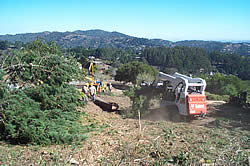
National Fire Plan Success Story
Diseased Fire-Prone Trees Removed from Homestead Valley
Golden Gate National Recreation Area, California
National Fire Plan - Community Assistance

Diseased pines were removed from park land near the Amaranth subdivision.
In September 2007, a 1-acre stand of non-native Monterey pine was removed from Golden Gate National Recreation Area (GGNRA) to improve fire protection for the Amaranth subdivision and property owned by the Homestead Valley Land Trust. The project was completed through a partnership between FIRESafe MARIN and Marin County Fire Department with support from the Amaranth Homeowners' Association.
This project was a continuation of previous National Fire Plan work conducted in 2005 that removed non-native pines south of this stand, also on GGNRA lands.
The Homestead tree removal project is part of a 40-mile long fuelbreak system outlined in the Marin County Community Wildfire Protection Plan (CWPP). The 2.4 mile Homestead Valley section of the fuelbreak extends along Panoramic Highway from 3-corners to Mountain Home Inn.
The trees removed were an average of 60 feet tall and ranged from approximately 10 inches to 62 inches in diameter. They included approximately 35 Monterey pine trees, 1 Monterey cypress, and 1 Douglas-fir.
Most of the pines were infected with pine pitch canker (Fusarium circinatum or PPC) a fungal disease that affects numerous pine species. Studies show that PPC was introduced to the U. S. from Mexico through the southeastern states. The disease was first detected in California in 1986 in Santa Cruz County. Since then, it has spread to nineteen counties ranging from Mendocino to Los Angeles, causing pine mortality primarily along the California coast. The abundance of Monterey pines planted in the residential areas of Marin County was identified as a significant fire hazard in the county's CWPP. Even uninfected trees are highly fire-prone.
The PPC fungus obstructs the flow of water and nutrients in infected trees. Typically, needles turn yellow, then red, followed by needle loss, leading to bare branches. The most apparent symptom is the resinous pitch that develops at the site of the infection, forming a canker. Tree mortality may not occur if one branch becomes infected, however, many trees have multiple infections which can cause full dieback. The pathogen has been isolated from a number of bark, twig, and cone beetles which are thought to transmit the disease.
Contacts
- Wendy Poinsot, Environmental Planner, NPS Wildland Urban Interface Program, Phone: (415) 464-5208
- Kent Julin, Registered Professional Forester, Marin County Fire Department, Phone: (415) 499-3759